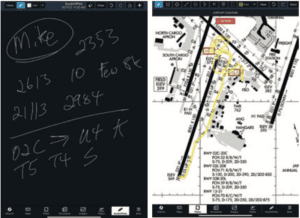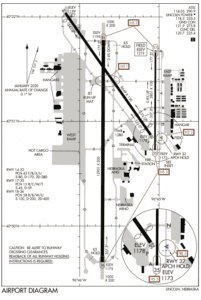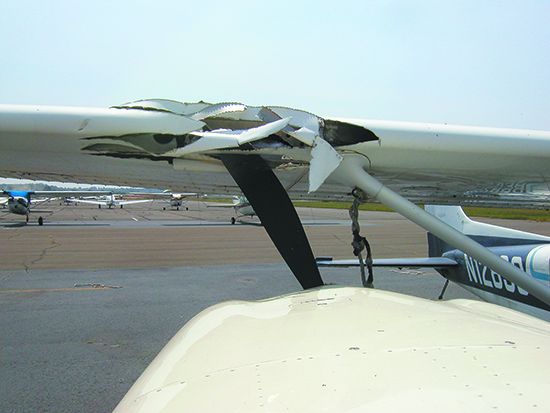One of the high-profile, close-call incidents that occurred this year was a runway incursion at JFK, where an American Airlines 777 taxied across a runway without a clearance. This forced a Delta 737 crew to abort their takeoff. According to the NTSB, the aircraft came within 1400 feet of each other. An extremely visible event, to be sure, but not so different from occurrences bordering on threats that occur frequently at busy (and sometimes even not-so-busy) airports. The following strategies can help all aviators avoid the dreaded mahogany desk, or worse.
Constant Vigilance
The moment you step on airport property, your legal, financial and personal risks go up substantially. (Arguably, this occurs any time you step out of the house, but this is not Personal and Automobile Safety Magazine, after all.) Ramp safety is important, and plenty of damage and injury has occurred before aircraft movement has begun. Be in the mindset of threat mitigation as soon as you get to the airport until the plane is safely put to bed. For ground operations specifically, this means taxiing heads-up and avoiding distractions like programming the panel or calling for release.
My rule of thumb is any task that requires my head to be down for more than a second will be done standing still. Often, this involves meeting ATC or your fellow pilots halfway. Blocking the only entrance for the runway in use is not considerate and, while perhaps necessary from time to time, should not be your first option. Most airports have designated areas that will allow you to set the brake and work through whatever distraction has popped up.
Keeping your head up is vital regardless of whether the airport is towered. Controllers can make mistakes, and other pilots can deviate from their clearance, such as in the JFK example. Never presume a runway is clear or that another aircraft will stop for you, and if there is ever a doubt, speak up. Do not rely solely on radio communications or TCAS/ADS-B for traffic awareness, because aircraft without such equipment still can occupy your space. Consider this a friendly reminder that as straightforward as it may seem, taxing is a critical phase of flight, and a sterile cockpit should be maintained when possible.
Airport Diagrams
With the prevalence of EFBs, this should be easier than ever. Obviously, some airports may not have a published airport diagram, but if one gets in the habit of displaying an airport diagram while taxing around, it could save a lot of headaches over a flying career.
This was a strictly enforced rule at my flight school, where the instructor would shut down the plane and make you run into the FBO to print an airport diagram out if you didn’t have one. I will never forget my first solo cross-country—my airport diagram apparently was not properly secured to my kneeboard and ended up good and crushed under my rudder pedals. The controller must have been used to dealing with student pilots, because after a semi-complicated taxi clearance and my half-correct readback, dripping with fear, he decided to give me progressive instructions to get me where I belonged.
It should be obvious that airport diagrams can help the planning and execution of ground operations. Using this tool to plan a taxi route to the runway, or from the runway to parking, can keep you ahead of the flight path. If there is an unexpected clearance, it may help highlight an ATC error or potentially missed construction Notam. Be careful with this technique, though, because assuming a taxi route can lead to confusion and confirmation bias when the clearance differs.
Confirm And Comply

Following along with the blue airplane symbol showing me where I am is a stone-simple matter once you’ve gotten comfortable with the feature, which you can do sitting in the comfort of your own home. —J.B.
One of my favorite things a controller can say is, “Thanks for checking.” It facilitates safety and promotes speaking up when one is unsure, which is a goal that every pilot and controller should share. If anyone in the plane has any doubt of what the clearance is, speak up. I cannot count how many times I have said the phrases, “Hey, XYZ Tower, are we cleared to land?” or, “Hey, Ground, are we cleared to cross Runway 4?” Never once have I regretted doing this. It is free insurance.
In my experience, both ATC and the pilot are well motivated to avoid errors (and paperwork), and this is a quick way to ensure everyone is on the same page. Never cross a runway unless you are 110-percent sure you have clearance or that you have visually scanned the area and made appropriate radio calls at a non-towered airport.
Write It Down
I have gone through stages where I felt that writing down taxi clearances was less efficient than just following along the path I was being assigned on the taxi diagram. If I anticipated a particularly complex route or was unfamiliar with the airport, I would write it down and then read it back. Granted, I generally operate out of complex airports day-to-day, but I have learned that it is just easier to write it down all the time. Developing a shorthand for holding short and crossing clearances is a useful technique. For example, I write, “Taxi to 23 via Foxtrot, Uniform, November, cross 4L, hold short 4R” as “23 F U N /4L H4R.” Similar to confirming a clearance with ATC, never once have I written something on my scratchpad and regretted it.
Lights And Signage
Knowing what signs and lights indicate around the airport environment is critical. The AOPA Air Safety Institute has several great resources for this, including flash cards and kneeboard guides. Being able to quickly interpret signage at a runway turnoff can help maintain situational awareness and keep the airplane where it is supposed to be. Additionally, at larger airports, there are some additional lights that provide a layer of safety when entering a runway. Runway Status Lights, Runway Entrance Lights and Takeoff Hold Lights are being rolled out to enhance awareness and prevent inadvertent takeoffs or runway entries. Typically, they will indicate red for stop when an action is unsafe. There also are videos available from the FAA if you want more information on these, but long story short is ATC and the safety features must agree. If the lights are green (or not illuminated) but no takeoff clearance was issued, stay put. Conversely, if the controller cleared you for takeoff but the lights in front are red, ask the controller to make sure an error has not occurred.
Progressive Taxi
I hear this advice often. “If you don’t know where you are, just ask for a progressive!” It is good advice. Similar to, “If you do not like what you are seeing, just go around!” These words are said quite often, but it must be due to pilot pride that they are ignored quite often as well. I get it; it can be embarrassing.
Recently I was taxiing, and we needed to be pulled out of the sequence because of ATC flow. There was a double-letter taxiway, like taxiway M-A. So we were told M-A, A short of A2. I was looking for taxiway Mike, and assuming I was taking a left. Both were incorrect assumptions. My brain completely short-circuited.
I can’t remember exactly what I said but it was something along the lines of, “Where am I going?” The controller said, “Take a right turn ahead here at Mike Alpha, then continue on Alpha, hold short of Alpha 2.” Once he said “right turn” and my brain finally heard M-A instead of two separate taxiways, it all clicked and I knew what was expected of me again.
When in doubt, never be afraid to ask for help and, beyond that, do not be afraid to use plain language.

A hot spot is a location on an airport movement area with a history or potential risk of collision or runway incursion, and where heightened attention by pilots and drivers is necessary. These are highlighted in airport diagrams and should be reviewed in the Chart Supplement as part of your preflight and on an airport diagram before taxiing. If you want additional information on why a hot spot might exist, check your Chart Supplement. Some are obvious, like five- or six-way intersections, but others are not nearly so at first glance. At right, the FAA uses the airport diagram for the Lincoln (Neb.) Airport, KLNK, as an example of the different ways hot spots can be charted.
Local Knowledge
A lot of people see busy, complicated airports and think they must require great skill to navigate. I am not going to say it’s easier than a smaller, less complicated airport, but what some overlook is how frequently professional pilots end up at these busier airports. What one gains from this repetition is local knowledge. Often the first time experiencing an airport like ORD, ATL or DFW is a challenging experience, and you can hear examples of this listening to LiveATC.net’s audio feed at one of them. Once you’ve been once or twice, it’s substantially easier to navigate because you know what to expect, making it is easier to stay ahead of things and avoid incursions.
There are ways you can obtain (some) local knowledge prior to heading to a new unknown. Many EFB applications, such as ForeFlight, have a notes/remarks section where pilots can give feedback for parking and airport tips. If anyone you know has flown there, give them a shout. Odds are, you will get information beyond the scope of ground operations but, as they say, “knowledge is power.” Consider also calling the FBO. This has the added benefit of giving the FBO your rough ETA, which can prevent employees leaving if the day is slow. Clearing the runway is not the first time you should be reviewing the airport layout.
Staying Grounded
A lot of this probably feels basic. Ground operations generally are. When a runway or taxiway incursion is analyzed, one of the contributing factors typically could be mitigated with these strategies. Reading it is one thing, but daily discipline is what will drive complacency down. Keeping complacency out of ground operations is an easy way to help keep everyone out of trouble.
After a career as a Part 135 pilot, flight instructor and check airman, Ryan Motte recently got hired by a major airline and is now flying as a Part 121 first officer.




